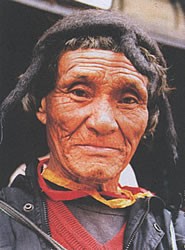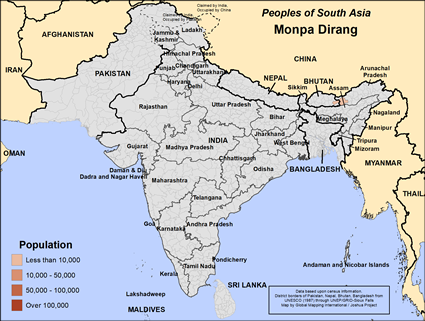Monpa Dirang in India

Photo Source:
Copyrighted © 2026
Peoples of the Buddhist World, Asia Harvest All rights reserved. Used with permission |

Map Source:
People Group data: Omid. Map geography: UNESCO / GMI. Map Design: Joshua Project
|
| People Name: | Monpa Dirang |
| Country: | India |
| 10/40 Window: | Yes |
| Population: | 7,200 |
| World Population: | 7,200 |
| Primary Language: | Tshangla |
| Primary Religion: | Buddhism |
| Christian Adherents: | 0.77 % |
| Evangelicals: | 0.00 % |
| Scripture: | New Testament |
| Ministry Resources: | Yes |
| Jesus Film: | Yes |
| Audio Recordings: | Yes |
| People Cluster: | South Asia Tribal - other |
| Affinity Bloc: | South Asian Peoples |
| Progress Level: |
|
Introduction / History
The Dirang Monpa have been granted status in India as a scheduled tribe. One of the alternate names for the Dirang Monpa is Sangla, which suggests that they may be related to the large Tsangla ethnic group of Bhutan, China and India.
The Dirang Monpa claim that they were the first inhabitants of the Dirang area. Some of their elders say their forefathers originated in eastern Bhutan, before migrating to their present location in India.
The Dirang Monpa live in the Dirang Circle in the West Kameng District of Arunachal Pradesh in northeast India.
What Are Their Lives Like?
The diet of the Dirang Monpa consists of cereals, fish, meat, vegetables, and chhung (local drink brewed from maize, rice, millet, wheat and buckwheat). Maize is the staple food item. They eat beef, pork, mutton, fowls, yaks, mithuns, and deer. They eat many fruits: apples, peaches, bananas, pomegranates and oranges.
Marriage in Dirang Monpa society is a simple procedure. They hire a lama to consult the horoscopes to determine the most auspicious time and day for a wedding to take place. Family members and friends gather at the bride's home. The lama simply places a white scarf, called a katha, around the necks of the bride and groom, blesses the couple, and they are married. Then they have a huge feast. Everyone gets drunk on rice whiskey, even the children.
The lamas perform many other roles in the community as well, in keeping with the important role that Tibetan Buddhism plays in the daily lives of Dirang Monpa society. After a baby is delivered, the mother is not allowed to leave the room for seven days. She is considered in a state of spiritual and physical pollution, and nobody can visit her. When the baby is three days old, they invite the lama to name the child. He prays and prepares a horoscope for the baby. The horoscope determines the name of the child.
Not only is the Buddhist lama present at birth, but he also officiates at funerals. When there is a death, the body is carried to a nearby river and thrown into the water after being cut into 108 pieces (Tibetan Buddhists consider 108 to be an auspicious number). If a person dies in an accident his or her body is buried. When a lama or an influential person dies, the body is cremated. On the seventh day after the death the lama says a prayer and erects a festoon in front of the house of the deceased to satisfy the soul. On the ninth day, the last day of the mourning period, there is a feast.
What Are Their Beliefs?
Tibetan Buddhism has a strong grip on the lives of the Dirang Monpa.
What Are Their Needs?
They need the Holy Spirit to open their eyes so they can see Jesus.
Prayer Points
Pray for loving workers to go to the Dirang Monpa people, and for their hearts to be ready to receive their savior.
Pray for families of believers loving and serving others to grow reproducing churches.
Pray for a chain reaction of families reaching families that result in thousands of new disciples who share their faith with others.
Pray for grace and truth expanding into their entire society as all believers learn to love others.